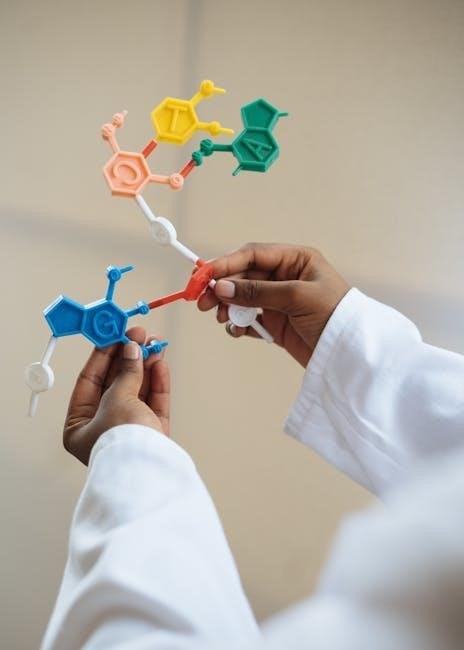
chemistry 1050 lab manual answers
Welcome to the Chemistry 1050 Lab Manual, designed for students at Memorial University. This guide covers essential experiments, safety protocols, and resources for successful lab work.
1.1 Overview of the Lab Manual
The Chemistry 1050 Lab Manual is a comprehensive resource for students, covering 11 experiments with detailed procedures and answers. It includes pre-lab questions, safety protocols, and post-lab submissions. The manual emphasizes chemical properties, reactions, and lab techniques, ensuring alignment with course objectives. Designed for Memorial University students, it provides clear guidance for experiments like water alkalinity and chemical transformations, fostering hands-on learning and understanding.
1.2 Importance of Lab Work in Chemistry 1050
Lab work in Chemistry 1050 is crucial for applying theoretical concepts, enhancing problem-solving skills, and developing scientific inquiry. It provides hands-on experience with equipment and techniques, fostering critical thinking and observation. Lab sessions allow students to explore chemical properties, reactions, and data analysis, preparing them for future scientific endeavors while aligning with course objectives and practical applications.

Key Experiments in Chemistry 1050 Lab Manual
Experiment 2 explores water’s alkalinity, while Experiment 3 focuses on chemical transformations. Experiment 7 covers inorganic preparations, emphasizing practical skills and chemical principles.
2.1 Experiment 2: Alkalinity of Water
Experiment 2 focuses on determining the alkalinity of water using titration with NaOH and Na2CO3. Students measure the pH and calculate the concentration of hydroxide ions, applying acid-base chemistry principles. This experiment emphasizes titration techniques and data analysis, providing hands-on experience with water quality assessment and chemical equilibrium concepts.
2.2 Experiment 3: Chemical Transformations
Experiment 3 involves chemical transformations, focusing on the preparation and identification of products through reactions. Students use crucibles, desiccators, and ethanol suction flasks to synthesize compounds. The lab emphasizes observing physical properties like color, odor, and solubility, and analyzing chemical changes. This experiment reinforces concepts of stoichiometry, purification, and characterization of chemical substances.
2.3 Experiment 7: Inorganic Preparations
Experiment 7 focuses on inorganic preparations, where students synthesize and characterize inorganic compounds. Procedures include using crucibles, desiccators, and ethanol suction flasks to isolate products. The lab involves techniques like filtration, drying, and purification. Students analyze the properties of the compounds and their reactions, gaining hands-on experience in inorganic chemistry and laboratory techniques.

Lab Procedures and Safety Guidelines
Lab procedures emphasize proper equipment handling, safety protocols, and emergency preparedness. Students must follow guidelines to ensure safe chemical practices and maintain a secure laboratory environment.
3.1 Crucible Handling and Cooling Procedures
Crucibles must be handled with care, using tongs when hot. After heating, place them in a desiccator to cool gradually. Avoid sudden temperature changes to prevent cracking. Always handle crucibles with heat-resistant gloves and ensure the area is clear. Proper cooling ensures safe handling and accurate experiment results, adhering to lab safety standards.
3.2 Safety Measures in the Lab
Lab safety is critical. Wear lab coats, goggles, and gloves. Closed-toe shoes are mandatory. Avoid loose clothing or jewelry. Tie back long hair and avoid nail polish or fake nails. Lab coats should be fully buttoned. No food or drink allowed. Handle chemicals carefully, and wear safety goggles when dealing with hazardous substances. Familiarize yourself with emergency exits and spill cleanup procedures to minimize risks and ensure compliance with lab protocols.
Common Post-Lab Questions and Answers
Students often ask about evidence of saltwater collection and chemical properties observed. Refer to the lab manual for detailed explanations and discuss results with your TA.
4.1 Evidence of Saltwater Collection in Receiving Flask
The collection of saltwater in the receiving flask is confirmed by the appearance of droplets, indicating successful condensation of vapor. This process aligns with chemical properties related to boiling points and vapor pressure, ensuring the experiment’s integrity and accurate results.
4.2 Physical and Chemical Properties Observed
Physical properties observed include state changes, such as boiling and condensation, while chemical properties involve reactions like rusting of iron in moist air. These observations align with principles of density, titration, and chemical transformations, providing practical insights into material behavior and reaction dynamics during experiments.
Resources for Chemistry 1050 Students
Access study materials from Memorial University, online platforms, and tools like Quizlet. Utilize AI Chat for instant solutions and study guides for exam preparation and lab work.
5.1 Study Materials from Memorial University
Memorial University provides comprehensive study materials for Chemistry 1050, including lab manuals, lecture notes, and practice exams. Access resources like Quizlet flashcards and AI Chat for instant solutions. The university’s library offers reserved texts and online platforms for exam preparation, ensuring students have ample tools to succeed in their coursework and lab assignments effectively.
5.2 Online Platforms for Lab Solutions
Online platforms like Quizlet and AI Chat provide instant solutions for Chemistry 1050 lab questions. These tools offer study materials, flashcards, and detailed answers to experiment-specific queries. Students can access solutions for experiments, such as alkalinity of water and chemical transformations, aiding in exam preparation and understanding complex lab procedures effectively.
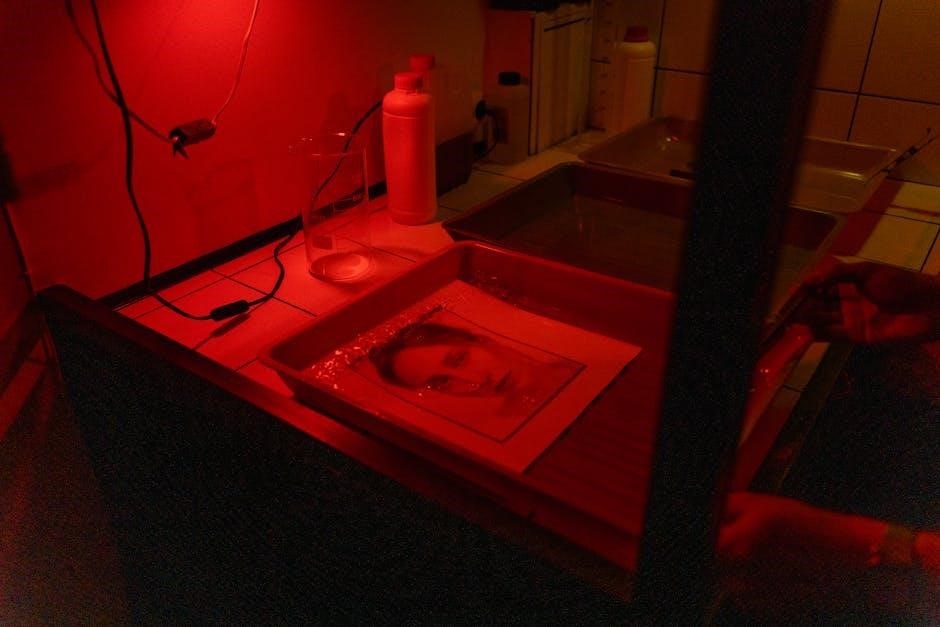
Lab Report Writing and Submission
Lab reports must be submitted promptly after each experiment. Missing lab work results in a zero grade. Timely submission ensures understanding of procedures and results.
6.1 Structure of a Lab Report
states the experiment’s purpose and hypotheses. Materials list all chemicals and equipment used. Procedure details the steps taken. Results present data and observations. The Discussion interprets findings and draws conclusions. Ensure clarity and accuracy in submission.
6.2 Consequences of Missing Lab Work
Missing lab work in Chemistry 1050 results in a zero for that experiment. Lab reports are mandatory, and absence severely impacts grades. If a lab is missed, students cannot submit a report, leading to a 20% reduction in the final grade. Regular attendance and participation are essential for success in the course.
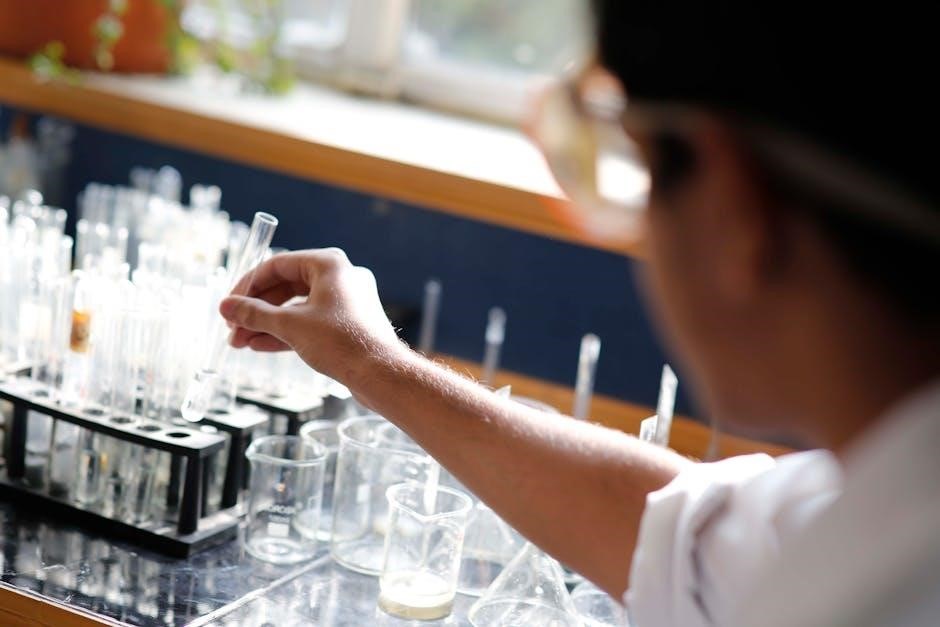
Exam Preparation and Solutions
Access midterm and final exam solutions, practice materials, and flashcards. Utilize Quizlet and AI tools for effective study. Memorial University provides comprehensive resources for exam success.
7.1 Midterm and Final Exam Solutions
Access comprehensive solutions for Chemistry 1050 midterm and final exams. Practice materials, flashcards, and study guides are available online. Memorial University provides structured resources, while platforms like Quizlet offer interactive tools. AI chat solutions and detailed answer keys help students prepare effectively. Utilize these resources to review and excel in your exams with confidence and clarity.
7.2 Practice Materials and Flashcards
Enhance your study routine with practice materials and flashcards tailored for Chemistry 1050. Platforms like Quizlet and Study Guide offer interactive flashcards covering key concepts, experiments, and chemical properties. Additionally, AI chat tools provide instant solutions and study aids. Utilize these resources to reinforce your understanding and prepare effectively for exams and lab work with confidence and clarity.

Experiment-Specific Solutions
Find detailed solutions for Chemistry 1050 experiments, including alkalinity of water and chemical transformations. Access resources like lab manuals and AI tools for instant assistance.
8.1 Solutions for Experiment 2: Alkalinity of Water
Determine the alkalinity of water using titration with NaOH and Na2CO3. Calculate the concentration of hydroxide and carbonate ions. Analyze data to find total alkalinity. Ensure accurate measurements and record results for precise conclusions. This experiment helps understand water quality parameters and chemical equilibrium principles.
8.2 Solutions for Experiment 3: Chemical Transformations
Analyze chemical transformations by observing changes in substances. Measure mass and volume accurately. Use crucibles and desiccators for cooling and storing samples. Record physical and chemical properties, such as color, odor, and solubility. Ensure proper setup of ethanol suction flasks for filtration. Interpret data to identify reactions and products, confirming chemical changes during the experiment.
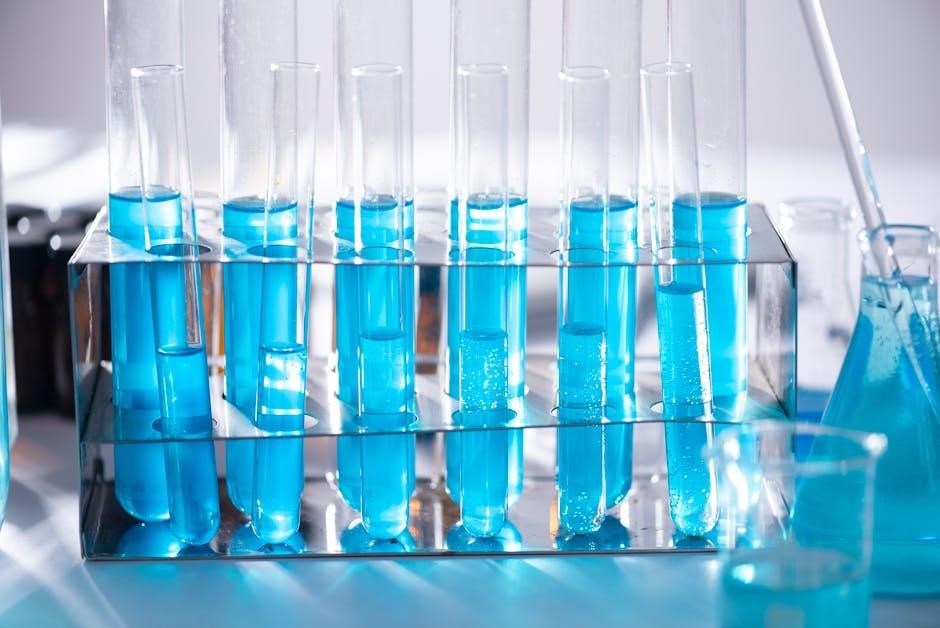
Lab Manual Availability and Editions
The Chemistry 1050 Lab Manual is available for purchase at Memorial University’s chemistry department or online. The 4th edition includes updated experiments and detailed solutions.
9.1 Purchasing the Lab Manual
The Chemistry 1050 Lab Manual can be purchased directly from Memorial University’s chemistry department or through authorized online retailers. Ensure you acquire the 4th edition for the most updated content, including experiments and solutions. It is advised to verify the seller’s authenticity to avoid outdated versions. Availability is confirmed for Fall 2024 students.
9.2 4th Edition Highlights
The 4th edition of the Chemistry 1050 Lab Manual features updated experiments, including Alkalinity of Water and Chemical Transformations. It offers enhanced safety guidelines, improved lab report structures, and additional resources for post-lab questions. New sections on titration procedures and inorganic preparations are included, ensuring comprehensive coverage for Fall 2024 students at Memorial University.
Lab Equipment and Techniques
Essential equipment includes crucibles, desiccators, and ethanol suction flasks. Techniques cover proper handling, cooling, and setup procedures to ensure precise and safe experimentation in Chemistry 1050 labs.
10.1 Use of Desiccators in Experiments
Desiccators are used to cool crucibles and maintain dry conditions. After heating, crucibles are transferred to desiccators to cool to room temperature, preventing moisture interference. This ensures accurate results in experiments like inorganic preparations. Proper desiccator use is crucial for maintaining sample integrity and experimental accuracy in Chemistry 1050 labs.
10.2 Ethanol Suction Flask Setup
The ethanol suction flask setup involves reconnecting the hose after crucible cooling. Ethanol is pulled into the flask to maintain vacuum conditions, ensuring efficient cooling and preventing contamination. Proper setup is crucial for experiments like inorganic preparations, as it aids in separating and purifying substances effectively while maintaining experimental integrity and safety protocols.
Chemical Properties and Reactions
This section explores key chemical properties and reactions, such as the rusting of iron in moist air and mercury’s unique liquid state at room temperature.
11.1 Rusting of Iron in Moist Air
Rusting of iron in moist air is a chemical reaction where iron reacts with oxygen and water, forming iron oxide. This process is accelerated by environmental factors like humidity and saltwater, demonstrating a key chemical property of iron. The reaction is oxidative and indicates iron’s susceptibility to corrosion in damp conditions, a fundamental concept in chemistry.
11.2 Mercury as a Liquid Metal
Mercury is a unique metal that exists in liquid form at room temperature, showcasing a distinct physical property. Its liquid state is due to weak metallic bonds and low melting point. This characteristic makes mercury useful in thermometers and barometers. Observing mercury’s properties helps students understand the relationship between atomic structure and physical states of matter in chemistry labs.
Density and Chemical Procedures
Density measurement for solids and liquids is a fundamental procedure in chemistry. It involves calculating mass and volume to determine density, aiding in chemical identification and analysis.
12.1 Density of Solids and Liquids
Density is a key physical property measured in lab experiments. For solids, mass is recorded using a balance, and volume via displacement. Liquids require a graduated cylinder for volume measurement. Accurate calculations ensure precise results, crucial for identifying substances and understanding their chemical properties.
12.2 Titration Procedures
Titrations involve measuring precise volumes of standard solutions to react with unknown concentrations. Acidity or basicity is determined using indicators like phenolphthalein. Accurate burette readings and endpoint identification are crucial. Regular calibration ensures reliable results. Common sources of error include improper mixing or contamination, emphasizing the need for careful technique and attention to detail during experiments.
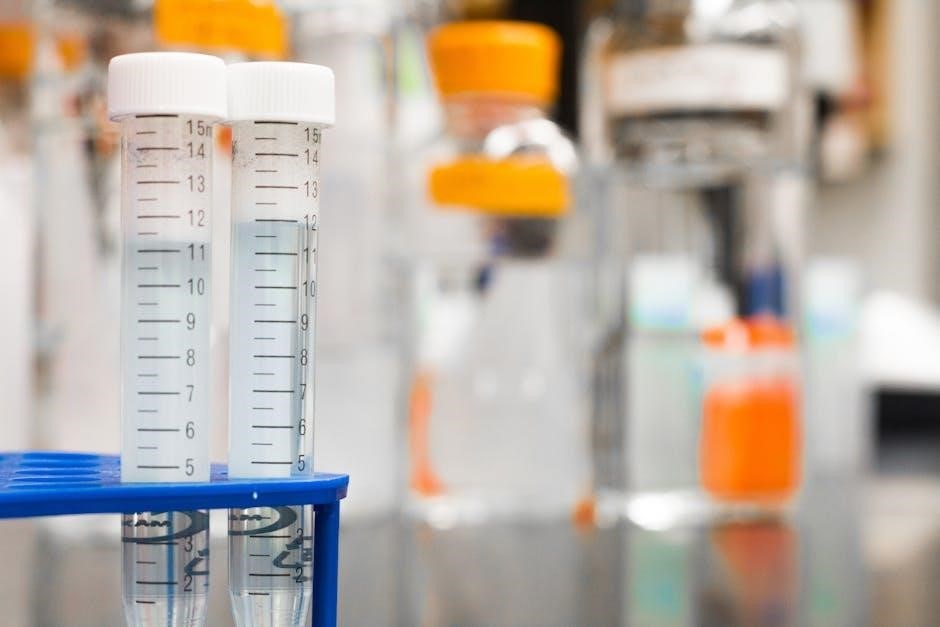
Lab Schedule and Deadlines
The Fall 2024 lab schedule outlines weekly experiments and submission deadlines. Missing labs results in a zero. Adherence to deadlines is crucial for full credit.
13.1 Fall 2024 Lab Schedule
The Fall 2024 lab schedule is comprehensive, outlining 12 weekly experiments; Week 1 covers Experiment 2: Alkalinity of Water. Weeks 3 and 5 focus on Chemical Transformations and Inorganic Preparations, respectively. Density of Solids is scheduled for Week 7, while Titration Procedures are in Week 9. Week 11 includes the final lab, and Week 12 is reserved for review and the final exam. Adherence to deadlines is critical to avoid penalties.
13.2 Submission Deadlines for Lab Reports
Lab reports must be submitted one week after the corresponding lab session. Late submissions incur a 10% penalty per day, with a maximum of three days before no submissions are accepted. Ensure all reports are handed in as both hard copies and online through the designated portal to meet the Fall 2024 deadlines and maintain full grading eligibility;
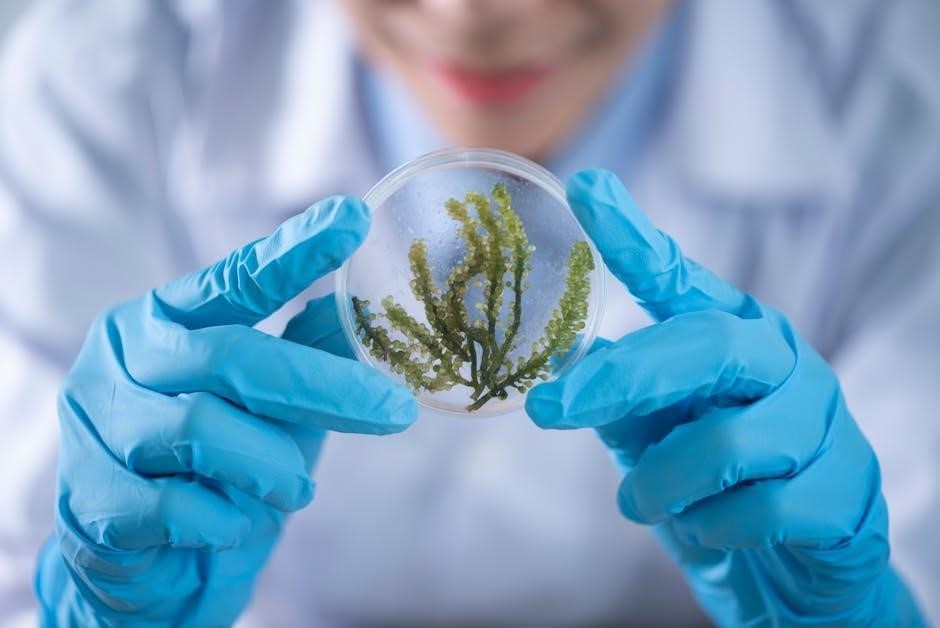
Online Study Tools and Flashcards
Use Quizlet for comprehensive flashcards and AI Chat for instant solutions to excel in your Chemistry 1050 studies and lab work effectively.
14.1 Quizlet for Chemistry 1050
Quizlet offers comprehensive flashcards for Chemistry 1050, covering key concepts, lab procedures, and experiments. Students can study terms like density of solids, chemical transformations, and evidence of saltwater collection. Digital flashcards and study guides provide an interactive way to master lab manual content and prepare for exams. Accessible on mobile, Quizlet is a popular tool for effective learning and exam preparation.
14.2 AI Chat for Instant Solutions
AI Chat provides instant solutions for Chemistry 1050 lab questions, offering real-time assistance with chemical equations, lab procedures, and post-experiment analyses. Accessible 24/7, it aids students in understanding complex concepts and troubleshooting lab challenges. AI Chat also offers personalized study guides and practice problems, making it a valuable tool for exam preparation and mastering lab manual content efficiently.
Memorial University Chemistry Department
Memorial University’s Chemistry Department supports student success through structured courses and accessible resources, ensuring a comprehensive understanding of chemistry principles and lab practices for Chemistry 1050 students.
15.1 Course Structure and Requirements
The Chemistry 1050 course at Memorial University is structured to enhance understanding through hands-on lab work and theoretical studies. Students must complete experiments, such as Alkalinity of Water and Chemical Transformations, and submit reports by specified deadlines. The department provides access to lab manuals, study materials, and online platforms to ensure support for student success.
15.2 Access to Lab Manuals and Resources
The Chemistry 1050 lab manual can be purchased from Memorial University’s Chemistry department. Supplementary resources, including online study platforms and practice materials, are available to aid student learning. Tools like Quizlet provide interactive study aids, ensuring comprehensive support for understanding and excelling in the course.

Final Exam and Study Guides
Access review materials and practice exams for the final exam. Utilize study guides and tools like the Pomodoro timer to enhance your preparation effectively.
16.1 Review Materials for Final Exam
Review materials for the final exam include practice exams, study guides, and flashcards. Utilize online resources like Quizlet and AI Chat for instant solutions. Focus on key concepts from experiments, chemical properties, and lab procedures. Ensure thorough preparation by solving previous years’ papers and seeking help from tutors. Effective time management using tools like the Pomodoro timer can enhance your study efficiency.
16.2 Pomodoro Timer for Effective Study
The Pomodoro Timer is a time-management tool that divides study sessions into 25-minute focused intervals, followed by 5-minute breaks. This technique enhances productivity and reduces burnout. For Chemistry 1050, use it to review lab manuals, practice experiments, and solve problems. Combine it with Quizlet flashcards and AI Chat solutions for efficient exam preparation and better retention of key concepts.